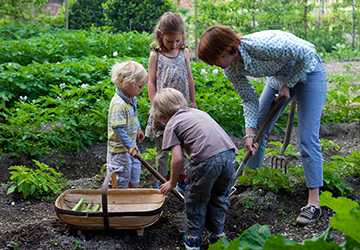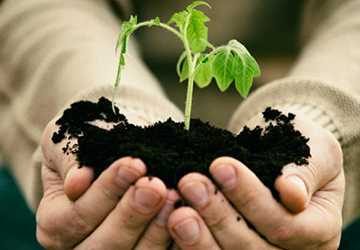Hey there, green-thumbed enthusiast! Are you ready to dive into the delightful world of vegetable gardening? Whether you possess a diminutive terrace or an expansive verdant expanse, cultivating your vegetables is gratifying and profoundly satisfying. Let's break it down into four simple yet effective tips for flourishing your garden.

Pick the Perfect Spot
Commence by judiciously selecting the optimal locale for your horticultural endeavour. Given the photosynthetic predilections of most vegetables, it is imperative to identify a site bathed in a minimum of 6-8 hours of direct solar irradiance per diurnal cycle, thus achieving an environment conducive to thriving agricultural productivity.
But if you're dealing with a shady area, don't fret! Veggies like lettuce, spinach, and broccoli can handle a bit less sun. Next up, consider the soil. Vegetables thrive in well-drained, nutrient-rich soil. If you harbour uncertainties about the quality of your soil, consider having it assessed at a nearby garden centre.
Incorporating compost or organic material can yield remarkable improvements if your soil needs rejuvenation. Remember, the better the soil, the happier your veggies will be!
Choose the Right Veggies
Now comes the fun part – choosing which veggies to grow! When deciding, consider what you love to eat and what grows best in your region. Starting with easy-to-grow options like tomatoes, peppers, cucumbers, and zucchini is a good idea for beginners. These veggies are relatively low-maintenance and perfect for boosting your gardening confidence.
Additionally, contemplate the available space. Some veggies, like squash and pumpkins, need more room to spread out, while others, like herbs or cherry tomatoes, can thrive in pots or small raised beds. And remember companion planting! Some plants grow better when paired with others, like basil with tomatoes or carrots with peas. It's like nature's little support system!
Water Wisely
Watering might seem straightforward, but there's more to it than meets the eye. Overirrigation may precipitate rhizogenic decay, while insufficient irrigation might precipitate desiccation and physiological stress in your botanical specimens. Achieving an equilibrium and assiduously attending to the hydric requirements of your plants constitute imperative facets of their overall welfare.
A general rule of thumb is to water deeply but infrequently. Promote the growth of robust, deep roots in plants by utilizing a watering can or a drip irrigation system. Direct the water towards the plant's base, avoiding contact with the foliage to prevent potential diseases.
Keep an eye on the weather, too. On hot, sunny days, your garden might need extra hydration. But during rainy periods, you can give your watering can a break. Watering in the morning or evening helps minimize evaporation, giving plants the optimal opportunity to absorb the water effectively.
Embrace Maintenance
Last but not least, let's talk about maintenance. Like any good relationship, your garden needs love and attention to flourish. Regularly check for pests like aphids or caterpillars, remove them by hand, or use organic sprays if necessary.
Keep an eye out for weeds, too. They compete with your veggies for nutrients and water, so keeping them in check is essential. Mulch is a highly productive method of retaining soil moisture and impeding the proliferation of weeds surrounding your botanical specimens.
Additionally, be sure to harvest your plants regularly! Picking your veggies at the right time ensures they're at their peak flavour and quality. Plus, harvesting encourages plants to produce more. It's a win-win!
Soil Health and Nutrients
Fertile soil forms the foundational pillar of triumph for any prosperous vegetable garden. Initiate the horticultural process by apprehending the pH level inherent in your soil; a preponderance of vegetables exhibits optimal growth within the spectrum of soil acidity that traverses from marginally acidic to neutral.
Effectuate a modification in your soil's pH profile by judicious adding amendments, such as lime, to rectify acidic soil or sulfur to ameliorate alkaline soil conditions. Concomitantly, ensure a recurrent enhancement of your soil matrix through the incorporation of organic materials of an edible nature, exemplified by compost, aged manure, or the assimilation of leaf mould.

This practice not only enhances soil structure but also boosts its nutrient content. Rotate your crops annually to prevent nutrient depletion and reduce the risk of soil-borne diseases. Crop rotation also helps balance the nutrients used by different plants, ensuring a more sustainable and healthier garden.
Pest Management and Beneficial Insects
While pests can be a gardener's nightmare, there are practical and eco-friendly ways to manage them. Cultivate an environment conducive to the proliferation of advantageous arthropods, including Coccinellidae, Chrysopidae, and predatory Acari, recognized for their predation upon ubiquitous horticultural pests. Flowers like marigolds, calendula, or alyssum can attract these insects to your garden.
Opt for alternatives that pose minimal harm to beneficial insects and are safer for your vegetables. Systematically scrutinize your botanical specimens for manifestations of pest-induced damage and expeditiously remediate issues to preempt the dissemination of infestations.
Seasonal Care and Crop Planning
Comprehending the climatic idiosyncrasies indigenous to your locale and orchestrating horticultural pursuits consonant with the temporal cycles is paramount for the triumph of a vegetable garden.
Certain botanical entities, exempli gratia tomatoes and peppers, evince exuberance in thermally elevated environs, whereas counterparts such as lettuce and broccoli manifest zenithal flourishing within the ambit of more temperately nuanced atmospheres.
Plan your garden layout and planting schedule to make the most of each season. Use companion planting techniques to maximize space and improve plant health. For example, interplanting fast-growing crops like radishes with slower-growing ones like carrots can help optimize space and increase yield.
Sustainable Practices and Environmental Stewardship
As gardeners, we care for the environment and practise sustainable gardening techniques. Use organic fertilizers and pesticides to minimize harm to beneficial insects, soil organisms, and the broader ecosystem.
To protect water reserves and lessen your impact on the environment, adopt water-saving techniques like mulching, drip irrigation, and rainwater harvesting. Compost kitchen leftovers and garden debris to diminish landfill waste and create a beneficial organic material for your garden.
Conclusion
Growing your vegetable garden can be an enriching experience. By following these tips – choosing the perfect spot, selecting the right veggies, watering wisely, and embracing maintenance – swiftly advancing along this horticultural trajectory, you shall expeditiously find yourself relishing the fruition of a copious harvest. Prepare yourself for gardening by putting on your gloves, and let's start growing!







